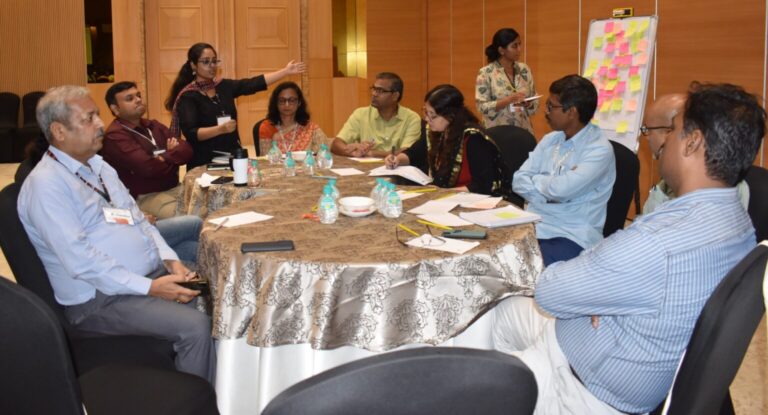Author : Shriram Bharathan R, Advisor, Environmental Sustainability
Anthropogenic emissions (emissions caused by human activity) have caused climate change and the impact of this climate change affect all life – from microbes to humans and oceanic behemoths on the planet – negatively. The European Environment Agency estimates that the economic loss due to climate change in Europe between 2010-2020 was 145 billion Euros. For organisations, climate change poses challenges on several aspects of everyday operations including:
- changing market dynamics along with demand–supply considerations
- employee well-being
- business infrastructure
- supply chain management including health and well being of supply chain stakeholders
- resource utilisation constraints including availability and changing economic value.
This, in effect, requires organisations to make a shift from an economic centric shareholder growth paradigm, to a comprehensive collaborative stakeholder growth paradigm.
But what accelerates climate change?
Greenhouse gases emitted into the atmosphere have accelerated global climate related effects. Since the Industrial Revolution, human activity has driven the quantity of CO2 (Carbon Dioxide – a greenhouse gas) up by 50% in the atmosphere (to 421 ppm in 2022 up from nearly 280 ppm maintained over the previous 10,000 years) (Source: NOAA). Nearly every human action is causing some effect on the overall emissions levels of the planet, over and above the minimum required to sustain life on the planet. A key side effect of the increase in human-induced greenhouse gases in the atmosphere is global warming, which in turn has the following repercussions (this is a sample list):
- Loss of food and freshwater systems
- Increased occurrence and severity of natural disasters
- Increased migration leading to high pressure on cities and urban infrastructure
- Extinction of natural habitats and species
- Warming of the oceans and changing weather patterns affecting monsoons and via correlation drought
- Melting polar ice caps and subsequent rise in sea levels.
At 500 ppm (estimated to reach by 2050 or earlier at current linear growth numbers), we will reach a global temperature increase of 3 C by the turn of the century (Source: Yale University). There are various tipping points that have been identified and the occurrence of these tipping points will ensure that the temperature rise becomes more difficult to reverse.

Image Source: Carbon Brief
Take for example, the cities of Bengaluru, Gurugram and Mumbai. Peak summer temperature over the last decade has risen by nearly 5 degrees in Bengaluru, approaching 40 C. Gurugram has seen a peak summer temperature of over 48 C, in 2022 and Mumbai has seen temperatures around 41 C consistently over the last 10-12 years across multiple instances. All three cities have seen frequent heatwave warnings in the recent past. Temperature-based challenges during monsoon and winter are also well known in the recent years. (Temperature Source: IMD)
Are governments doing anything about this?
Climate summits since the 1980s have tried to throw light on the matter and in 2015 (the Paris COP Summit) the summit had successfully helped in committing to achieving targets for reductions in emissions from each country.
To mitigate some of the challenges posed by climate change, countries have committed to achieving INDCs (a.k.a climate targets) within a fixed time frame with sub-targets for achieving in 2025, 2030, and up to 2050. These commitments have further been refined in the Glasgow summit 2021 (COP 26) recently. India has committed to the following INDCs:
- To put forward and further propagate a healthy and sustainable way of living based on traditions and values of conservation and moderation.
- To adopt a climate-friendly and a cleaner path than the one followed hitherto by others at corresponding level of economic development.
- To reduce the emissions intensity of its GDP by 33 to 35 per cent by 2030 from 2005 level.
- To achieve about 40 per cent cumulative electric power installed capacity from non-fossil fuel based energy resources by 2030, with the help of transfer of technology and low cost international finance, including from Green Climate Fund.
- To create an additional carbon sink of 2.5 to 3 billion tonnes of CO2 equivalent through additional forest and tree cover by 2030.
- To better adapt to climate change by enhancing investments in development programmes in sectors vulnerable to climate change, particularly agriculture, water resources, Himalayan region, coastal regions, health and disaster management.
- To mobilize domestic and new and additional funds from developed countries to implement the above mitigation and adaptation actions in view of the resource required and the resource gap.
- To build capacities, create domestic framework and international architecture for quick diffusion of cutting edge climate technology in India and for joint collaborative R&D for such future technologies.
But despite all countries providing their INDCs, the net outcome as a result of implementation of these INDCs stands as below:

Image Source: Climate Action Tracker
Additional action is required to limit the temperature increase to 1.5 C or lower by the turn of the century.
So, what should Industry be doing? Linking Climate Change and ESG.
It’s not just countries that are committing to climate impact reduction goals, but corporates are doing so as well. Action by corporates will not only support a country’s goals but also help in reducing the exposure to climate risk.
Many organisations have recognised the need for being ESG-ready as one of the action points in dealing with the negative impact of climate change (a starting point on ‘What is ESG?’ can be found here). In brief, ESG is a comprehensive collaborative stakeholder approach that helps in managing sustainability and improving an organisation’s capability in handling and managing climate risk for themselves and their stakeholders. Companies redefining sustainability strategy are looking at ESG frameworks today for evaluating the risk and impact of their business
The ESG framework is a good starting point. Policies are being implemented by the Government to initiate and spur everyone into action. The INDCs can be interpreted to require the following aspects from organisations – increased renewable energy, energy utilisation optimisation and climate-friendly process of economic activity, requirement of carbon sink, support vulnerable areas from the impact of climate change, and drive innovation. In addition, India has passed the Electricity Amendment Bill 2022. This law allows for some significant actions in our journey to address climate change:
- The Bill allows for competition among energy suppliers and cross-usage of existing infrastructure. This will improve quality, transparency and efficiency of grid electricity and performance.
- It mandates distribution companies to purchase a percentage of their energy from renewable sources
- Proposes to create a carbon market for domestic trading of carbon emissions and reductions on a voluntary and compliance basis leading to cap and trade scheme for corporates with incentives for those who go above and beyond
- A ban on exporting carbon credits generated within the country to overseas markets until Indian targets are met. Surplus can be exported for higher realization of economic and environmental benefits.
In addition, one of the regulatory bodies, SEBI has prescribed that the top 1000 listed companies report their ESG parameters in a comprehensive BRSR document over the next few years and the top 250 listed companies to report ESG for their organisation and supply chain. (To know more about how organisations have reported in the first year of disclosures, please do check out our article here). The requirements to comply with regulations will only increase but with a robust ESG strategy organisations lead the change by being Climate Action Champions.
A few organisations have taken the lead to voluntarily disclose and mitigate their climate risk. These organisations have also gained benefits with increased economic performance, rising investor and stakeholder confidence. While there is a certain effort in the direction to mitigate climate change risk, it is not even close to what is required to secure our futures.
What can businesses and corporates do?
- Familiarise themselves with the requirements of the BRSR and the INDCs.
- Create an ESG strategy and roadmap to help achieve compliance, improve operational performance and contribute towards a sustainable future
- Implement the ESG strategy and roadmap with third party assessment on performance annually
- Integrate various organisational activities to the ESG strategy including activities on marketing and CSR
- Disclose and improve performance every year
- Realise the tangible benefits of implementation and improvement in overall organisational performance while improving stakeholder confidence in the brand.
Ready to start your organisation’s journey to climate positivity? Get in touch with our Corporate Sustainability and ESG Solutions unit at esg@sattva.co.in




